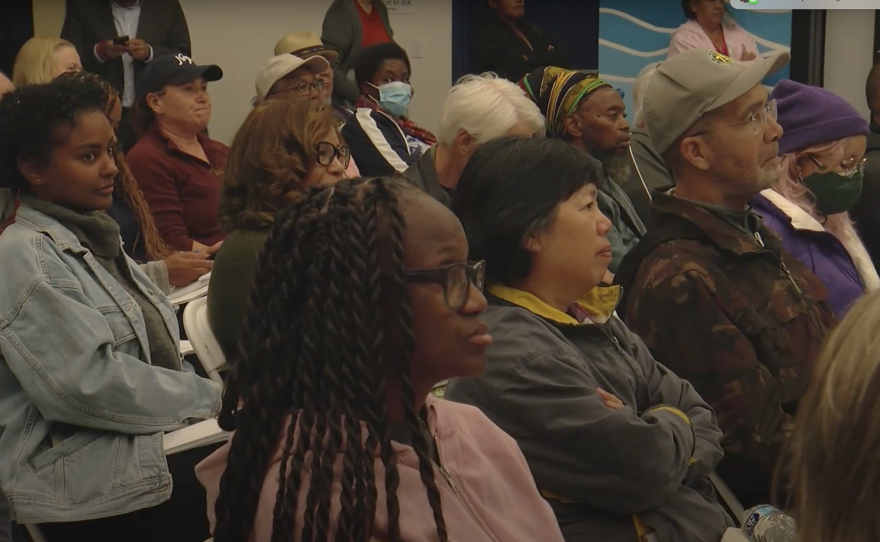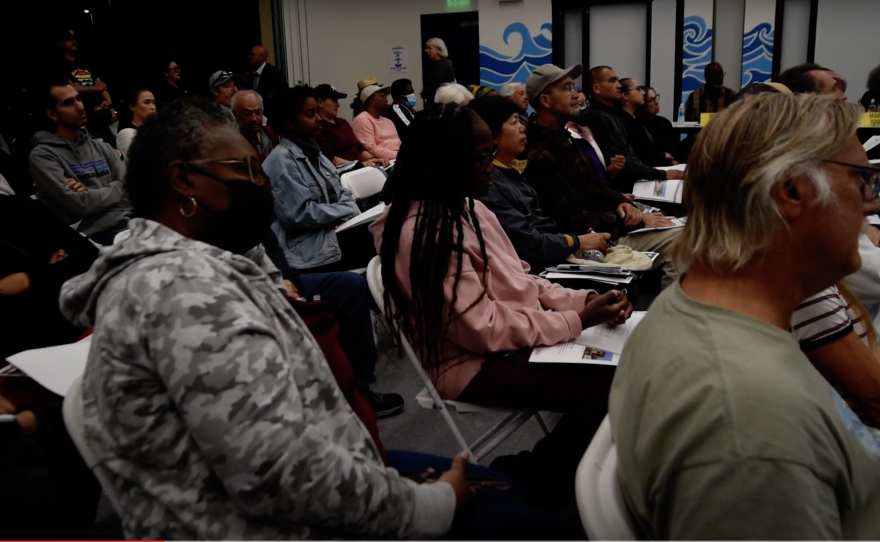The highest point of Emerald Hills is an empty lot with radio towers.
It offers 360-degree views of San Diego.
Neighbors would like to see an iconic park there, like Kate Sessions in Pacific Beach. Maybe a youth or senior center.
But it’s private land. Two years ago, city staff announced a housing development would be built there.
Martha Abraham lives nearby. She was upset.
The zoning map appeared to allow about 70 houses on that parcel. But the developer is planning to build more than 120.
“We would say, like, it's not zoned for this many houses, and we would be told by the developer, it is zoned for that many houses,” she said.
Her community planning group tried to get an explanation for the discrepancy.
“When we go to our council member for support, we're being told, ‘Oh, we support housing,’” she said. “They weren't helping us, so we had to just try to help ourselves.”
Helping themselves was time-consuming.
“I was putting my own business and projects to the side to work on this. Because what happens is that you get into a little rabbit hole. You find one thing, and then it leads you into another, and it leads you into another,” she said.
They searched through more than a thousand pages of laws and public records. For what, she wasn’t exactly sure.
“I feel like there was a magic bullet, and we just hadn't found it yet,” she said. “There was something going on that no one was telling us about.”

Then the city announced another development in Encanto, again with twice as many houses as zoning seemed to allow.
Rob Campbell lives down the street.
He said the issue he has isn’t about building housing, but the number of homes.
“We're identified as an environmental justice-affected community. And so we don't see how paving over what green space we have will increase our air quality or will decrease the heat island effect that we suffer from,” he said.
The planning group wanted to appeal the development, but the city began charging planning groups a $1,000 appeal fee in 2022.
The area is mostly Black and Latino, and low-income.
They fundraised. Took off work for the appeal hearing. Stayed up late preparing. And made the trek downtown.
The city postponed the meeting.
“They said they had discovered some new information,” Campbell said.
He went home and reviewed the city’s rebuttal.
This had become his pattern – go to work, come home, eat dinner with the family, and retreat to the office to continue searching for answers for these developments.
There, in the city’s counter-appeal, was Abraham’s magic bullet: “Footnote 7.”
“What is this?” Campbell asked himself.
He pulled up the city’s zoning code. And in the R-S-1-2 column – the zone that applies to the radio towers lot in Emerald Hills and the newer development in Encanto – was a little number seven he’d never noticed.
He scrolled down several pages to get to the footnotes.
Footnote 7, passed in 2019, reduced minimum lot size from 20,000 square feet to 5,000 square feet – only in the city-designated Encanto and Southeastern Planning Areas.
“That was the first time I knew that we were different. But I didn’t know why,” he said.

Last week, more than a hundred neighbors filled a school community room and spilled out the back.
Andrea Hetheru, chair of the Chollas Valley Community Planning Group, presented what Abraham, Campbell and others had learned in their research.
She put the city code on the screen.
“You see that it says table 131-04D,” she began.
Neighbors knit their brows and squinted.
“We usually skip over them without a second thought,” she said. “We never expect a footnote to be shocking. And that is the entire point. There is city code in the form of a footnote that is shocking.”
“With this footnote, the city is essentially saying, 20,000 means 20,000 to everyone in the city except you folks in Southeast. For you folks in Southeast, 20,000 means 5,000. A dollar means a quarter, because we said so,” she said.
Hetheru walked them through due process and federal law.
“You're going to hear us say AFFH a lot,” she said. “We want you to be able to say it like you're brushing your teeth . . . AFFH, AFFH.”
Affirmatively Furthering Fair Housing requires local governments to actively dismantle housing discrimination.
“That doesn't mean to stop,” she told them. “It means to turn the clock backwards.”
She sped them through a century of history.
Redlining. Restrictive covenants.
Laws that followed the Civil Rights Movement.
And ways local governments tried to resist them.
This footnote, she said, is part of that resistance.
When Hetheru told how Campbell found the footnote, the room applauded.
More than a dozen neighbors stood to comment, including Russell Steppe.
“I understand we have the need for housing, but disrespect is disrespect, and the law is the law. Will we ever stand up and let the law do what it’s supposed to? Is the Constitution going to be true for all of us?” he said.
Representatives of the development company for the radio towers property, D.R. Horton, were there.
One neighbor stood to face them.
“I’m not a public speaker, so bear with me. My name is Mara, and I live in Emerald Hills. I know that you said you stand by your projects. I did a little digging . . .” she said, and listed out lawsuits against them.
Any nationwide company of their scale would have lawsuits, one representative responded.
To Campbell, the meeting was pure democracy.

The district’s city councilmember, Henry Foster III, was there.
He suggested the community members wait to hear more from the city.
A rumble moved through the audience.
“Footnote 7! Talk about Footnote 7! Footnote 7!” they called out.
Foster later said the meeting was a good thing.
“I appreciate them having the courage to, quite honestly, stand up and demand answers,” he said.
He was the district’s chief of staff when the footnote became law.
He said he shares their concerns about transparency and discrimination, but argues that some good came from the footnote: “It did spur housing.”
Monica Montgomery Steppe, the district’s council member who passed the footnote, did not answer questions about it.
In an email statement, she said: “As an elected official, I've always advocated for the balance of community input, the urgency of localized planning needs, and opportunities for first-time home buyers to build generational wealth. My decisions are guided by my longstanding commitment to transparency and enhancing residents' quality of life. While I firmly believe we must consider tailored solutions for communities facing historically unique challenges, I support community voices and input from city staff to ensure an outcome that reflects our shared goals to achieve equity in land use and housing.”
The city planning director at the time, Mike Hansen, said he doesn’t know why the footnote was included in the 2019 code update.
“I didn’t give direction for it to be included and didn’t work on it personally,” he wrote in an email. “As the City works on a fix, there could be an opportunity to review single-family zones more comprehensively so they reflect the values of the community today.”
Heidi Vonblum is the planning director now.
She said she wouldn’t recommend the footnote if it came before her now.
“Applying exceptions to generally applicable zoning regulations in specific communities, – in this case, in a community that is identified as a low resource area – is problematic and something that needs to definitely be evaluated,” she said.
She said she asked the state for permission to reconsider the footnote.
State law prohibits making housing zones less dense unless they make it more dense somewhere else.
To Campbell, the footnote feels like betrayal.
He’s still processing how this experience has shaped him, but said it did teach him one thing: Read everything.
“On the surface, I read a headline, and I just have to read inside because the headline can be very misleading,” he said.
If the state agrees, Vonblum said the city council could reconsider the footnote in mid-2025.
Meanwhile, the developers are moving forward.
Dan Boyd, a vice president for D.R. Horton, told the crowd at the meeting that he was proud of their activism, but, “We think what we're going to do is just move the project forward. I think what you're all going to do is try to get to the comfort level with everything here that we heard this evening.”





